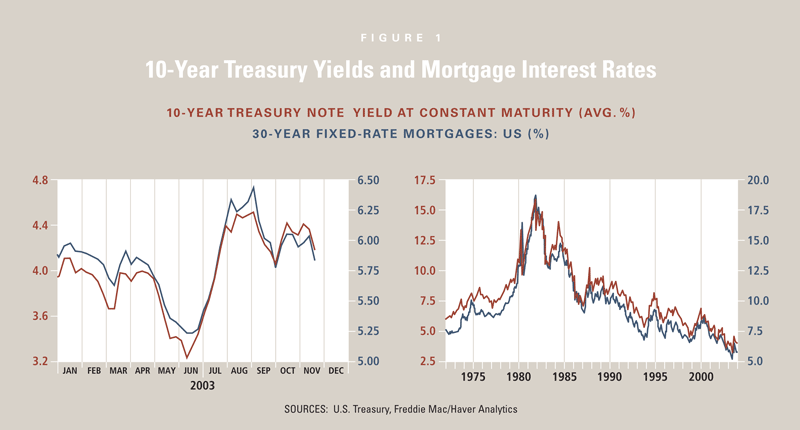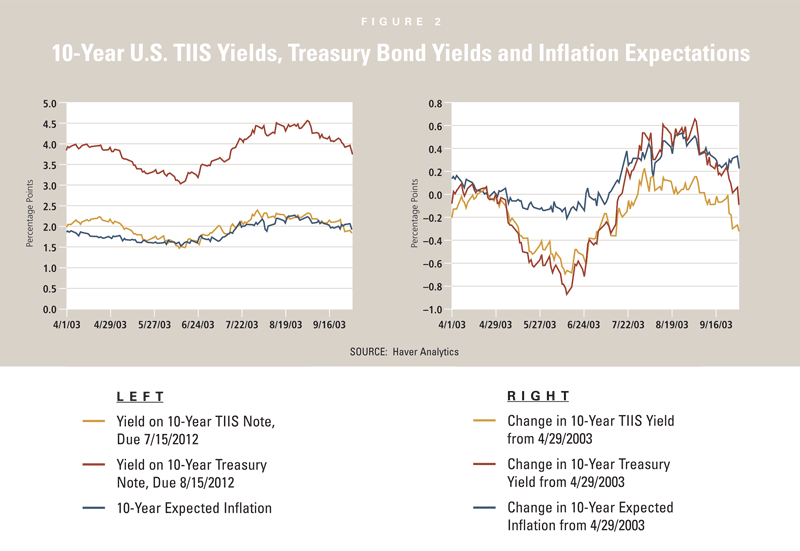Miscommunication Shook Up Mortgage, Bond Markets
Mortgage interest rates dipped to record lows early last summer, providing homeowners with a refinancing bonanza. This decline in mortgage interest rates mirrored a fall in the 10-year Treasury bond yield (the interest rate on the bond), as shown in the top panel of Figure 1. In fact—as shown in the bottom panel of Figure 1—mortgage interest rates almost always mirror the yields on long-term Treasury bonds because they respond to the same forces. What factors drove the sharp declines in yields on 10-year Treasury bonds in the spring of 2003? Was the Federal Reserve responsible for the volatility, as some in the financial press have alleged? And why are mortgage interest rates closely linked to these Treasury yields in the first place?
Last Summer's Bond Market
The top panel of Figure 2 shows that in May and June 2003, yields of U.S. 10-year Treasury notes plummeted before rising sharply in July and August.1 The same panel shows that the yield on this 10-year Treasury note fell from 3.97 percent on April 14, 2003, to about 3.01 percent on June 13, 2003, then rebounded sharply to a high of 4.53 percent on Sept. 2, 2003.2
The roots of the sharp swings in the bond market turmoil lay in concerns about deflation-a sustained fall in the general price level-generated by steady declines in core U.S. inflation rates that began in 2001. Such a decline in the inflation rate is disinflation. By the fall of 2002, the declines had reduced U.S. inflation to levels consistent with price stability.3 That is, inflation was no longer a consideration in people's economic decisions. In fact, inflation had declined so much that the Federal Reserve began to consider further declines to be unwelcome because they might lead to deflation.
Overinflated Deflation Fears
Deflation is unwelcome for several reasons. First, a sustained fall in the price level is incompatible with the Federal Reserve's commitment to price stability. Second, some feared that the Fed's usual monetary policy instrument-changes in the federal funds target-would be useless in a deflationary environment because of the zero nominal interest rate bound. The zero nominal interest rate bound simply means that interest rates cannot be negative because lenders would not pay to lend money when they can simply hold cash. If prices are falling, then the real interest rate (the nominal interest rate less the rate of inflation) must be at least as great as the rate of deflation. And the real interest rate is a much better barometer of the stimulative impact of monetary policy than the nominal interest rate. For example, if prices are expected to fall at a rate of 2 percent per year and the Federal Reserve sets nominal interest rates at their lowest possible level (0 percent), then the real interest rate is still 2 percent, a fairly high level if economic conditions are weak.
The zero nominal bound creates the incorrect perception that the Federal Reserve would be impotent in the face of deflation. Japan's economic problems over the past decade have contributed to this view. Since 1999, the Bank of Japan has seemed unable to stimulate the Japanese economy with conventional monetary policy and has seen very sluggish growth, coupled with some deflation. Some observers have worried that these problems might afflict the U.S. economy.
In November 2002, Federal Reserve Gov. Ben Bernanke gave a speech addressing the potential problem of deflation in the United States: "Deflation: Making Sure 'It' Doesn't Happen Here." Bernanke considered the chance of significant deflation in the United States to be "extremely small," but could not discount it entirely. To dispel the notion that the Fed would be helpless in the face of deflation, however, Bernanke reviewed some policy steps that the Fed could take to stimulate the economy if deflation did occur in the United States.4 The primary measure would be to buy longer-term bonds than the Fed usually buys (one year or less) in conducting open market operations, lowering long-term yields as well as short-term yields. In this manner, the Fed could pump liquidity into the economy, stimulating spending, raising prices and ending (or preventing) deflation.
The trigger for the bond market turmoil was Fed Chairman Alan Greenspan's follow-up April 30, 2003, to the semiannual monetary policy report to Congress. In that report, Greenspan said:
As you know, core prices by many measures have increased very slowly over the last six months. With price inflation already at a low level, substantial further disinflation would be an unwelcome development, especially to the extent it put pressure on profit margins and impeded the revival of business spending.
And the FOMC announcement of May 6, 2003, was widely interpreted to herald a prolonged period of lower short-term rates and/or the purchase of long-term bonds by the Fed to effect "easier" monetary policy:
The probability of an unwelcome substantial fall in inflation, though minor, exceeds that of a pickup in inflation from its already low level.
The mention of the minor possibility of "an unwelcome substantial fall in inflation," though couched in the most careful language, raised expectations of Federal Reserve purchases of long-term bonds to battle the specter of deflation.
Buy Low, Sell High
Financial markets are intrinsically forward looking. If the Federal Reserve is expected to buy long-term bonds in the future, raising the prices of those bonds, then bond traders will want to purchase those bonds today to take advantage of the future price rise. Consequently, bond prices rose (yields plunged) as demand increased in the wake of the May 6 press release and continued to rise (with yields falling) until the middle of June. The bottom panel of Figure 2 displays this pattern of yield changes.
On June 25, the FOMC held another policy meeting and cut the federal funds target by only 25 basis points-less than financial markets expected. The FOMC issued a press release that was almost identical to that published after the May 6 meeting:
The probability, though minor, of an unwelcome substantial fall in inflation exceeds that of a pickup in inflation from its already low level.
Despite the fact that the June 25 statement was almost identical to the statement that followed the May 6 meeting, bond markets were disappointed in the cut of 25 basis points in the funds rate target and were disappointed in the lack of plans for untraditional monetary policy measures, such as buying long-term bonds. Consequently, demand for long-term bonds began to fall, driving down prices and driving up yields. Long-term interest rates began to rise more strongly after the June 25 meeting.
Indeed, many in the financial press concluded that Greenspan had deliberately duped financial markets with the previous talk of an "unwelcome fall in inflation." His motivation was allegedly to jawbone down long-term interest rates, thereby stimulating the economy without actually having the Fed buy long-term bonds.
The Federal Reserve Open Market Committee meets today, and must begin clearing up the predictable mess after Alan Greenspan failed to keep up his impressive juggling trick. His plan was understandable and ambitious. Out of one side of his mouth, he talked up the economy to boost shares and consumer confidence. Out of the other, he muttered darkly about the small but significant risk of deflation and the willingness of the Fed to buy bonds to keep long-term interest rates low and encourage debt-fueled spending.
—"Time for clarity, Mr. Greenspan: The U.S. recovery is too precarious for the Fed to be vague." The Financial Times, Aug. 12, 2003
Expected Inflation or Expected Growth: What Changed?
To understand how the Fed's announcements might influence bond yields, it's helpful to look at the four components of interest rates of a particular maturity: default premium, expected inflation, inflation risk and the real component. The default premium compensates the lender for the possibility that the borrower will be unable or unwilling to pay the debt. The default premium is zero for dollar-denominated Treasury bonds because the U.S. government can always create money to repay such debt. Higher expected inflation raises interest rates because lenders demand compensation for the expected loss of purchasing power. Inflation is uncertain, however; so, lenders might also have to be compensated for the risk that it will exceed expectations-that compensation is the inflation risk premium. But current U.S. inflation is stable enough that the inflation risk premium is probably very small and unlikely to change rapidly; it can safely be ignored here. Finally, the real interest rates depend on the expected productivity of physical capital. A robust economy and high productivity encourage businesses to borrow to finance future production, bidding up interest rates.
Because the default premium is zero and the inflation risk premium is negligible for U.S. Treasury bonds, the yields on those bonds are effectively composed of the real interest rate and the expected inflation rate. Did the Fed's statements influence bond yields by changing expectations of inflation, real activity or both?
One can estimate real interest rates from the yields on Treasury inflation-indexed securities (TIIS).5 The principal and coupon payments on TIIS are indexed to increase with the consumer price index to protect investors from inflation, making the TIIS yields real yields. The difference between yields on conventional bonds and TIIS yields (called the TIIS yield spread) measures the market's expectation of future inflation. For example, on Jan. 27, 2004, the 10-year TIIS maturing in January 2014 had a yield of 1.83 percent, while a conventional Treasury bond maturing in November 2013 had a yield of 4.08 percent. That means the bond market expects inflation to average about 2.25 percent (4.08−1.83) over the next 10 years.
Complicating the usual interpretation, however, is the fact that principal payments on TIIS bonds are not reduced if there is cumulative deflation. (See "The Basics of Bonds" below for explanation.) Because of this, the TIIS spread will tend to overstate expected inflation. And greater probabilities of deflation will increase this bias.
The bottom panel of Figure 2 shows that from May through July, U.S. real interest rates (10-year TIIS yields) fell almost as much as 10-year nominal yields. Of course, U.S. TIIS spreads (expected inflation) fell much less than the U.S. real rate, slipping only about 20 basis points from April to mid-June before rising again. Unless the probability of significant cumulative deflation changed very dramatically without changing expectations of positive inflation-which seems unlikely-changes in real interest rates drove most of the fluctuations in Treasury yields. In other words, the Fed statements did not cause the bond market volatility by changing inflation expectations.
Was this decline in real interest rates due to lower forecasts of real growth over the next 10 years, or did expectations of Fed long-bond purchases or other untraditional measures lead to the fall? It seems unlikely that forecasts of real growth over 10 years should change very quickly, as 10-year average growth is a fairly stable variable and there was no significant news about slowing labor force growth or technological change to dramatically change the long-term growth picture. Consistent with stable 10-year growth forecasts, the Blue Chip consensus forecast of U.S. real GDP growth in 2004 actually increased slightly from May 10, 2003, to June 10, 2003. Instead, it seems much more likely that the Fed's pronouncements produced bond market expectations of significant long-bond purchases that drove bond prices up and yields lower.
The Long and the Short of It
The Federal Reserve, like most other central banks in developed economies, conducts monetary policy by targeting short-term interest rates. It is commonly accepted that the Fed, like other central banks, can change the real component of short-term interest rates by open market operations (OMO) with short-term (maturing in less than a year) bonds. A purchase of short-term bonds, for example, makes such bonds scarcer to the public, driving up prices and driving down yields. Actual transactions are not necessary, however. Central banks with a record for controlling interest rates can manipulate those rates by simply announcing the desired target.6
It is less common, however, that central banks conduct open market operations in the market for long-term bonds.7 The traditional view is that the Federal Reserve has conducted open market operations with short-term bonds because the market for short-term debt is much larger and more liquid than that for long-term liabilities and, thus, the Fed's transactions would not unduly distort short-term bond prices. Indeed, the Fed hasn't conducted OMO with long-term bonds since "Operation Twist" of the 1960s, and many are skeptical of the ability of a central bank to alter conditions in the long-term bond market in the same way as in the short end.8 While the Fed does influence the yields on long-term bonds by altering inflation expectations and possibly expectations of growth, such influence is indirect. The events of last spring, however, make it seem likely that the Fed inadvertently lowered the real component of long-term interest rates by influencing bond markets to expect purchases of long-term bonds. Indeed, the episode underscores the importance of expectations in determining bond market conditions.
Miscommunication
As consumers enjoyed extra cash from refinancing their mortgages at extraordinarily low interest rates last summer, very few were aware of the chain of events that had made their bonanza possible. Declining rates of core inflation sparked fears of deflation among the public. The Fed's efforts to inform the public of contingency plans to prevent such an occurrence created unintended expectations of Fed purchases of long-term Treasury bonds that drove down long-term Treasury yields and mortgage interest rates. When it became apparent that such expectations were unlikely to be borne out, bond yields and mortgage interest rates quickly readjusted to their previous levels.
The episode reinforces the importance-and the hazards-of keeping the public fully informed as to economic conditions and how the Federal Reserve might respond to them. Federal Reserve policy-makers believed that they were only stating the obvious-that inflation could be too low as well as too high-and that they had contingency plans to deal with such an eventuality, unlikely as it seemed. Financial markets, however, concluded that deflation was an imminent threat and that purchases of long-term bonds were forthcoming. When it became obvious in June that deflation was not imminent and that untraditional monetary policy measures were not forthcoming, the financial markets felt deceived. The Fed, on the other hand, felt perplexed at the bizarre interpretation of its statements. As the Federal Reserve better informs the public about its view of the economy and its role in it, one hopes such miscommunication will become less common.
Endnotes
- The U.S. Treasury calls its debt instruments that have two- to 10-year maturity at issuance "Treasury notes," while it terms debt instruments with maturities from 10 to 30 years "Treasury bonds." "Treasury bills" have a maturity of one year or less at issuance. The term "bond," however, can be used to refer to any security (i.e., bills, notes or bonds) with a fixed payoff. [back to text]
- The Treasury note in Figure 2 matures on 8/15/2012. The Treasury inflation-indexed security (TIIS) in the figure matures on 7/15/2012. [back to text]
- See Greenspan (2000). [back to text]
- Clouse, Henderson, Orphanides, Small and Tinsley (2003) describe ways in which monetary policy could stimulate the economy, even under the zero nominal bound. [back to text]
- The U.S. Treasury first issued TIIS in 1997 to provide investors with an opportunity for an inflation-protected investment. [back to text]
- Guthrie and Wright (2000) and Kohn and Sack (2002) examine how markets react to statements by the Reserve Bank of New Zealand and the Federal Reserve, respectively. [back to text]
- The Fed pegged interest rates on long-term Treasury bonds for many years prior to the Treasury-Fed accord of 1951. [back to text]
- See Beckhart (1972) and Zaretsky (1993). [back to text]
References
Beckhart, Benjamin H. "Federal Reserve System." New York: American Banking Institute and Columbia University Press, 1972.
Bernanke, Ben S. "Deflation: Making Sure 'It' Doesn't Happen Here." Remarks given before the National Economists Club, Washington, D.C., Nov. 21, 2002.
Clouse, James; Henderson, Dale; Orphanides, Athanasios; Small, David H. and Tinsley, P.A. "Monetary Policy When the Nominal Short-Term Interest Rate is Zero." Topics in Macroeconomics, Vol. 3, No. 1, Article 12, 2003. See www.bepress.com/bejm/topics/vol3/iss1/art12/.
Greenspan, Alan. Opening remarks to "Global Economic Integration: Opportunities and Challenges," a symposium sponsored by the Federal Reserve Bank of Kansas City, Jackson Hole, Wyo., Aug. 24-26, 2000.
Greenspan, Alan. Follow-up to the Semiannual Monetary Policy Report to the Congress, testimony given before the Committee on Financial Services, U.S. House of Representatives, April 30, 2003.
Guthrie, Graeme and Wright, Julian. "Open Mouth Operations." Journal of Monetary Economics, Vol. 46, No. 2, October 2000, pp. 489-516.
Kohn, Donald L. and Sack, Brian P. "Central Bank Talk: Does It Matter and Why?" Unpublished manuscript, Board of Governors of the Federal Reserve System, May 23, 2003.
Zaretsky, Adam. "To Boldly Go Where We Have Gone Before-Repeating the Interest Rate Mistakes of the Past." Federal Reserve Bank of St. Louis The Regional Economist, July 1993, pp. 10-11.
Views expressed in Regional Economist are not necessarily those of the St. Louis Fed or Federal Reserve System.
For the latest insights from our economists and other St. Louis Fed experts, visit On the Economy and subscribe.
Email Us




